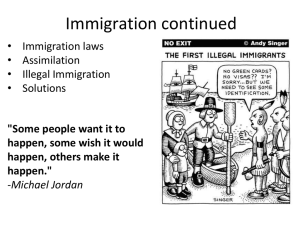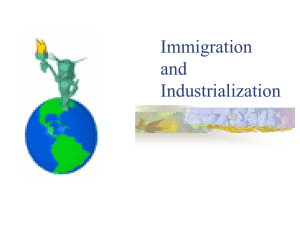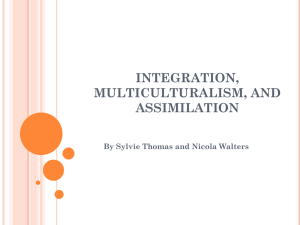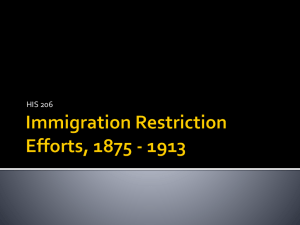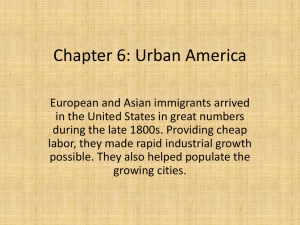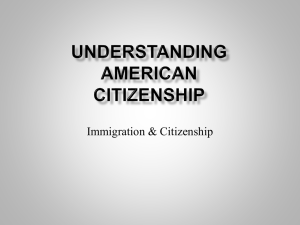Is assimilation inevitable?
advertisement
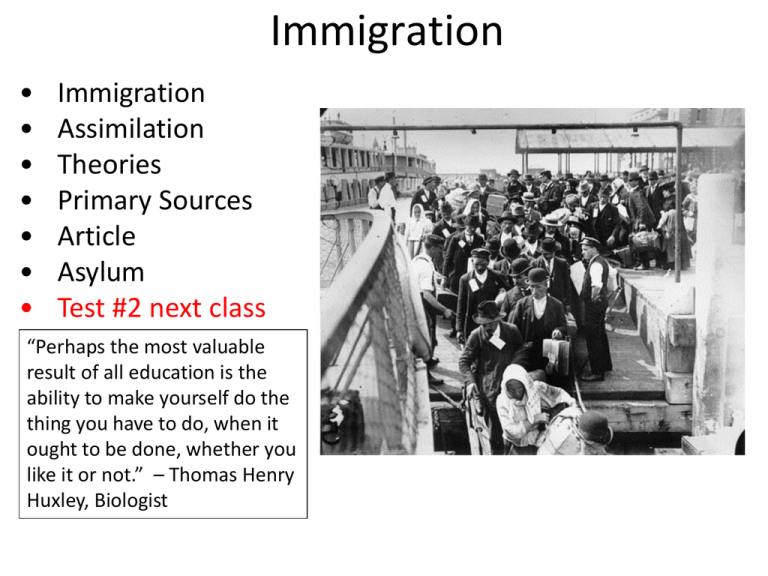
Immigration • • • • • • • Immigration Assimilation Theories Primary Sources Article Asylum Test #2 next class “Perhaps the most valuable result of all education is the ability to make yourself do the thing you have to do, when it ought to be done, whether you like it or not.” – Thomas Henry Huxley, Biologist Where are most legal immigrants from? Top 10 in 2010 Source: U.S. Department of Homeland Security http://www.dhs.gov/xlibrary/ assets/statistics/publication s/natz_fr_2010.pdf Mexico India Philippines China Vietnam Colombia Dominican Republic Cuba Haiti Jamaica What parts of the U.S. do most immigrants settle in? What parts of the U.S. do most immigrants settle in? And why? California Illinois New York New Jersey Florida Texas Push and Pull factors of Immigration into the U.S. Push factors poverty famine unemployment wars military draft religious or political persecution Push and Pull factors of Immigration into the U.S. Pull factors perception of endless opportunities employment family religious freedom economic freedom education I am a ... 1. 2. 3. 4. First generation immigrant (came to the U.S. not born here) Second generation (parents came to the U.S., born here) Third generation (grandparents came to U.S.) Family has been in the U.S. more than 3 generations What is assimilation? Assimilation 1. Robert E. Park’s traditional assimilation theory 2. Milton Gordon’s contemporary views 3. Horace Kallen’s cultural pluralism . Robert Park’s traditional assimilation model, assimilation occurs after 3 generations. • 1st: struggle to learn the new way of new country, hold on to many aspects of their culture American According to Robert Park’s traditional assimilation model • 2nd: attend public schools learn English better than parents may move out of ethnically grouped neighborhoods marry someone outside of their race. Still seen as outsiders and may consider themselves outsiders American Robert Park’s traditional assimilation model • 3rd: grandchildren of immigrants, move completely into mainstream of American life. May learn a few words of grandparents’ language, know a few recipes, or proverbs, but speak mostly English Few questions regarding their nationality American According to traditional assimilation model, assimilation occurs after 3 generations. • 1st: struggles to learn the new way • 2nd: learn English better than parents, move out of ethnically grouped neighborhoods, marry someone outside of their race. Still seen as outsiders • 3rd: move completely into the mainstream American life. In your opinion or personal experiences has this been true? Criticism of traditional assimilation model 1. Ignores age of entry 2. Ignores race 3. Ignores choice Criticism of traditional assimilation model 4. Ignores group size, concentrations, and time of entry 5. Ignores similarity between the cultures Milton Gordon’s Contemporary Views on Assimilation Gordon described 7 different sub processes of assimilation Milton Gordon’s Contemporary Views on Assimilation Some feel that not all are possible 1. Cultural (practices and traditions) 2. Structural (schools, jobs, housing, recreational spheres of society) 3. Marital (acceptable partners) 4. Identificational (the group you identify with) 5. Attitudinal (prejudice) 6. Behavioral (discrimination) 7. Civic (political power, representation in politics) assimilation. Melting Pot vs. Salad Bowl Italian Cuban Japanese Italian Cuban Cultural Pluralism America America Japanese Horace Kallen’s Cultural Pluralism Majority’s culture should not replace minority’s culture But add to it Minority group’s ways should be accepted Should be seen as “Americanized” without disappearing as distinctive groups Italian Cuban Cultural Pluralism America Japanese Melting Pot vs. Salad Bowl Which do you feel is better for the United States? Why? Cultural Pluralism Primary Sources Images from the California Library of Congress 1. Walk around and view all of the images 2. Stand by the image that interests you most (NO MORE THAN 3 PEOPLE PER IMAGE) 3. With the others at your image answer the following questions: (Try avoiding group members that already sit near you) a) Why did you select this image? b) What do you think is happening in this image? Who? What ? Where? When? c) Why do you think this image was selected for class? d) Select a speaker e) Return to your seats when you hear the buzzer Interested in the historical background? Visit the Library of Congress website Washington D.C. Largest library in the world http://www.loc.gov/index.html Chiricahua Apaches as they arrived at Carlisle from Fort Marion, Florida November 4th, 1886 “Kill the Indian and save the man” ~ Captain Richard Henry Pratt, Founder, Carlisle Indian School, PA Title: Group of Indian Boys, from Dakota territory, taken after about fifteen month's residence at Hampton, Virginia. March, 1880. Educating the Indians. Illustration. Frank Leslie’s Illustrated newspaper, 15 March 1884. Title: View of Ellis Island Looking across water toward immigration station New York 1913. http://www.youtube.com/watch?v=r_zDeHhJox8 "Work on the Last Mile of the Pacific Railroad -- Mingling of European with Asiatic Laborers": From Harper's Weekly: Harper's Weekly, Vol. 13 Image created 1869 Chinese immigrants made up 90% of workers on U.S. railroads in mid to late 1800’s. However white workers did not allow Chinese immigrants to be in the photo marking the completion of the railroad to the West Coast Music for the Nation: American Sheet Music The Chinamen must go by H. B. Pasmore. CREATED/PUBLISHED San Francisco: Gibson, J. W., 1880. 1860’s New York. Discrimination against Irish in the job market. Political cartoon titled "The Usual Irish Way of Doing Things" by Thomas Nast (1840-1902) published in Harper's Weekly on September 2nd 1871 History of Discrimination in Immigration Law • Chinese Exclusion Act 1882: excluded Chinese laborers for 10 years • Immigration Act of 1921: restrictions Southern and Eastern Europe, quota for each nationality. Japanese American Internment During World War II Title: Japanese residents at Civil Control station for registration San Francisco April 1942 After Pear Harbor attack, President Franklin Roosevelt ordered that everyone who was one-eighth Japanese or more be confined in detention centers called “internment camps” with no trials, no crime charge http://www.youtube.c om/watch?v=C7NVY BfZ310 Japanese American Internment During World War II Title: Residents of Japanese ancestry awaiting the bus at the Wartime Civil Control San Francisco, April 1942 htt p:// ww w.y out ub e.c om /w atc h? v= 6m r97 qy KA 2s &fe atu re= rel ate d Attorneys for Brown v. Board of Education George E. C. Hayes, Thurgood Marshall, and James M. Nabrit congratulating each other on the Brown vs. Board of Education decision, May 17, 1954. United States Supreme Court’s landmark decision that declared segregation in schools unconstitutional Ruby Bridges New Orleans, Louisiana 1960, when she was 6 years old, her parents responded to a call from the NAACP and volunteered her to participate in the integration of the New Orleans School system. She is known as the first African-American child to attend an all-white elementary school in the South http://www.youtube.com/watch?v=4nrkMxorZT4&feature=related Oct 1954, Baltimore, Maryland, USA --- Police stand guard as a group of African American students, escorted by Reverend James L. Johnson, march past demonstrators protesting desegregation at Baltimore high schools.. Cesar Chavez 1960’s Mexican-American farm worker, labor leader and civil rights activist who co-founded the National Farm Workers Association. His work led to numerous improvements for union workers. https://www.youtube.com/watch?v=zeo-q-8MOQ4 Cesar Chavez, Robert Kennedy Cesar Chavez breaks his 25-day fast by accepting bread from Senator Robert Kennedy, Delano, California. Left to right: Helen Chavez, Robert Kennedy, Cesar Chavez March 10, 1968 When Filipino American farm workers initiated the Delano grape strike on September 8, 1965 to protest for higher wages, Cesar Chávez eagerly supported them. July 31st, 2010 Temecula, CA “Small group protests the building of a mosque in Temecula” LA Times “We are more alike, my friends, than we are unalike.” Quote from Poem Human Family by Maya Angelou History of Discrimination in Immigration Law National Origins Act 1924: Southern Europeans and East Asians and Indians 1950’s eject suspected Communists from the country (usinfo.state.gov) History of Discrimination in Immigration Law Great Depression: Mexicans and Mexican-Americans faced mass deportation Post World War II: 1954 "Operation Wetback," President Eisenhower, a speculated 1 million Mexicans deported along with their U.S. born children Effects of Post 9/11 Security Measures USA Patriot Act of 2001: put immigration under control of Department of Homeland Security 2003: Men from Pakistan and Saudi Arabia in US, legal immigrants, had to register for the controversial National Security Entry-Exit Registration System or face deportation. The ethnicity of immigrants was a focus during times of national crisis Illegal Immigration Terms Immigrant does not = illegal immigrant Illegal immigrants also called undocumented workers/ undocumented students Remember immigrant does not =Latino/a Be respectful Article on Immigration Solutions (1) More border control. (2) Prevent employers from hiring undocumented immigrants. (3) Withhold government services from unauthorized immigrants. (4) Grant workers a path to gain citizenship or work permits. (5) Give police the authority and responsibility to identify illegal immigrants (Arizona SB 1070) Groups 1. Each person: introduce yourself 2. Tell your group when your birthday is (just day and month, not year) 3. Put your group in order from 1-5 depending on your birthday (Jan-Dec) Pros and Cons of the Solutions a) Which do you think is best? Why? b) Which do you think is worst? Why? c) List 1-3 other pros or cons for each solution. (Besides those already in the article) (1) More border control. (2) Prevent employers from hiring undocumented immigrants. (3) Withhold government services from unauthorized immigrants. (4) Grant workers a path to gain citizenship or work permits. (5) Give police the authority and responsibility to identify illegal immigrants (Arizona SB 1070) ILLEGAL IMMIGRATION Views for deportation of illegal immigrants Views against deportation of illegal immigrants Asylum protection granted by a nation to someone who has left their native country as a political refugee Asylum may be granted due to Fear of return to country based on persecution related to: •race •religion •political opinion •social group Must show: •10 years in U.S. •Otherwise clean criminal record •Relative who is U.S. citizen would suffer exceptional hardship if deported Extra Credit Movie Next class Test #2 Use Study Guide Tuesday March 11th, 2014 • Come to class on time • Bring a scantron (standard 50 question scantron 882-E) and pencil • Study class notes, slides on website, articles and textbook reading assignments. Use the study guide! • 25 questions, multiple choice (ICE= United States Immigration and Customs Enforcement)
